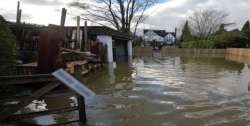Water receding in Srinagar, lakhs still waiting for help
Srinagar: Water levels have started receding in Srinagar city, one of the worst hit by the deluge, facilitating rescue workers to pluck out another 29,000 persons to safety but four lakh people were today still

Srinagar: Water levels have started receding in Srinagar city, one of the worst hit by the deluge, facilitating rescue workers to pluck out another 29,000 persons to safety but four lakh people were today still waiting for help in the flood-ravaged Kashmir Valley.
Scaling up rescue work, Army and IAF have deployed 329 columns and 79 aircraft and helicopters to evacuate those stranded and provide food and medicines.
"A massive rescue and relief operation by Indian armed forces is continuing on a war footing in Jammu and Kashmir with over 76,500 persons rescued so far by the Armed forces and NDRF in different regions of the state", PRO, Defence, Col G D Goswami said today.
"79 transport aircraft and helicopters of Indian Air Force and Army Aviation Corp have been pressed into service.
Army has deployed 329 columns of its personnel for rescue and relief operations, in which 244 columns deployed in Srinagar region and 85 columns in Jammu region", he said.
In general the water level is receding but areas downstream of Jhelum River are experiencing increase in water levels, he said.
"In Srinagar town there is a decrease in water level by 3 to 4 feet since the beginning of the floods, whereas there is a rise of 6 inches in Wuller Lake. Manasbal Lake saw a reduction by 3 inches bringing the water level to 18.3 feet, which is still 4.3 feet above danger mark," the PRO said.
Srinagar town remains the most critical part of flood hit areas.
"All those areas where it was not possible to reach earlier remain the focus of the rescue mission today," he stressed and added that the reas of Rajbag, Jawahar Nagar, Gogji Bag and Shivpora where the bulk of the stranded people are located saw major effort for evacuation.
While greater desperation was seen in areas which are on the outer fringes, people in the interiors of these colonies are displaying a great sense of responsibility and directing the rescue teams to those people who are worse affected.
Many camps of Army located in South Kashmir and Srinagar have also been flooded and over 1000 Army personnel and families are stranded without food and water. Water, electricity, supplies and other services have been hit within the cantonments.
Authorities were also trying to fix telecommunication links snapped since Sunday afternoon on a war footing and hope to restore it in a phased manner.
As the miseries faced by people--some of them perched on rooftops--in the worst floods to hit Jammu and Kashmir in six decades unfolded, the death toll in the floods, landslides and house collapses triggered by torrential monsoon rains since Tuesday last was stated to be around 200.
In an endeavour to provide speedy medical aid to the affected populace, 80 medical teams of the Armed Forces Medical Services have also swung into action.
The Army has distributed 8,200 blankets and 650 tents, 1,50,000 litres of water, 2.6 tonne of biscuit, 7 tonne baby food and 28,000 food packets in the flood-affected areas.
Additional water bottles are being airlifted from Chandigarh and Delhi, he said.
More relief material including 2000 hospital bed sheets, blankets and tents, water bottles and cooked food are being airlifted today.
So far 613 sorties have been undertaken by helicopters and aircraft of Armed Forces and 715 tonnes of relief material has been dropped by the Indian Air Force, he said.
135 Army boats and 148 NDRF's inflatable boats are actively involved in the rescue operation. To restore road connectivity, five task forces of Border Roads Organisation, which include 5700 personnel, have been pressed into service.
As of now, road connectivity has been restored between Batote-Kishtwar and Kishtwar-Sinthan Pass. Work between Sinthan Pass and Anantnag is in progress and the Jammu-Poonch road has been cleared for traffic.
Fifteen engineering task force teams along with boats and other life-saving equipment have already reached the flood affected areas to supplement the rescue operation, Goswami said.
Army rescue teams, during the course of evacuation are also interacting with the stranded persons, assuring them that they are comparatively in safer places.
Army Chief Gen Dalbir Singh Suhag is scheduled to visit the city today to review the flood situation and take stock of the rescue and relief operations by the armed forces in the flood-ravaged Kashmir Valley.